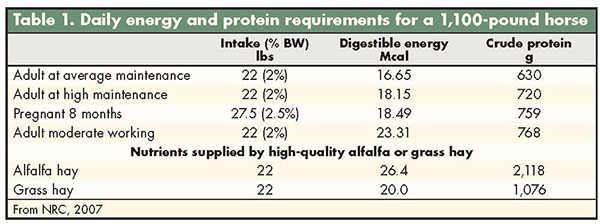Producing hay for the horse market can be a profitable enterprise but brings a different set of considerations compared to selling hay destined for ruminant livestock.
At the recent Western Alfalfa & Forage Symposium in Reno, Nev., Emily Glunk, a horse owner and the extension forage specialist at Montana State University, discussed how both horses and their owners have unique needs. For starters, most horse clientele are going to prefer small square bales because often they don’t have the equipment or facilities to handle the large hay packages.
“Many horse owners do not come from farming or ranching backgrounds,” explained Glunk. “They normally aren’t part of the hay-making process, and they rely heavily on their veterinarian or the internet for information on how they should feed their horses. As a result, relationships between the hay producer and horse owner become important.”
Glunk noted that even though horses are not ruminants, they still have an effective fiber requirement. Forages should comprise the basis for any horse diet. That said, not all horses have the same nutrient needs. The nutritional requirements for a horse will vary based on production (activity) level, age and maintenance needs. Horses that are at maintenance with average to low activity levels can usually have energy and protein needs met with grass hay (Table 1). “It’s rare that a horse’s protein needs don’t get met, though specific amino acids may sometimes be an issue,” said Glunk.

Energy excess
Only in cases where a horse has a high activity level or during pregnancy is top-quality alfalfa really needed to meet energy requirements. “Overfeeding energy results in horses becoming too fat,” said Glunk. “Research studies have estimated that nearly 50 percent of the horse population is overweight.”
Many horse owners are now becoming more cognizant of feeding excess sugar in the diet. “This is fueled by the fact that more horses are experiencing equine metabolic issues such as laminitis, insulin resistance and obesity,” explained Glunk. For horses with metabolic syndrome, the recommendation is to feed hay that is below 12 percent nonstructural carbohydrates (NSC). The forage specialist noted that this doesn’t necessarily mean to feed only grass hay. She pointed out that sometimes grass hays have a higher NSC content than alfalfa.
Forage anti-quality factors are also more heavily scrutinized by horse owners than by most other types of hay buyers. Many horse owners maintain a “no weeds” policy, whether it impacts the forage quality or not. Of greater concern are any traces of mold. Horses are more sensitive to moldy hay than ruminant livestock. Consumption of moldy hay has been linked to impaired breathing, digestive upsets and recurrent airway obstruction (RAO or heaves). Mold spore count risk and action levels are presented in Table 2. Mycotoxins produced by some molds may impact reproductive performance.

Consistency is important
“Horse owners still place high value on the visual appearance of hay,” said Glunk. “They often equate outward appearance with nutritional value.” Factors such as color; content (species); stage of maturity; presence or lack of seedheads; and how the hay smells or feels still carry weight as to whether or not a horse owner is willing to purchase hay and for what price. Sun-bleached or weathered hay will often sell at reduced value even though it may be relatively high quality.
Horses do not adjust easily to changes in their diet. Glunk cited research studies that confirmed horses experiencing abrupt changes in diet are more predisposed to colic, a digestive disorder resulting in severe abdominal pain. “This can be brought on by both changes in the type of hay as well as in the amount of forage fed,” explained Glunk. She suggested that changes in the type of hay fed be done gradually.
Build relationships
The horse industry is an important market for U.S. hay producers. To capture premium prices in this market, hay sellers need to understand that horses utilize forage differently than ruminant livestock. Providing a consistent hay product is important. Hay sellers also will need to build a relationship of trust and communication with the horse owner. It will demand a bit more effort and perhaps biting of tongue, but for the hay producer who is willing, there is extra profit to be captured.
This article appeared in the February 2016 issue of Hay & Forage Grower on page 20.
Not a subscriber? Click to get the print magazine.

